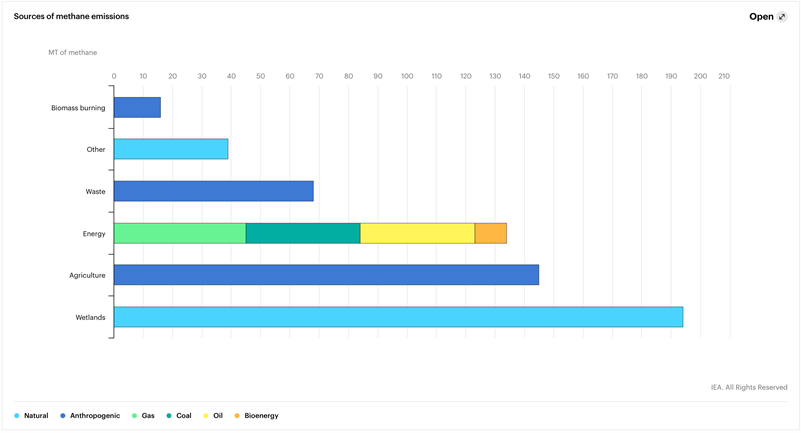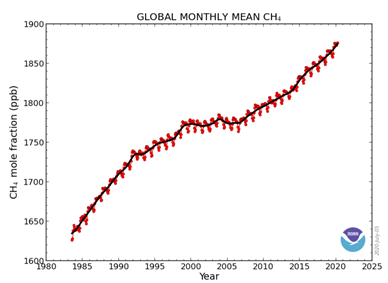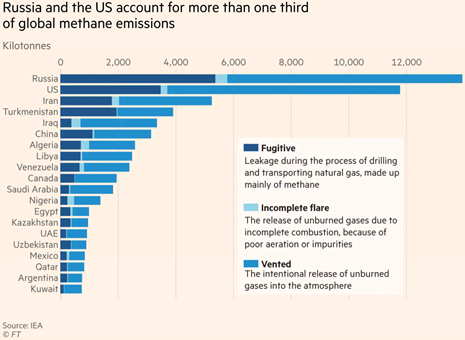A few weeks ago, we wrote a blog on reducing CO2 emissions in oil and gas operations. Based on the initial commitments coming out of the COP-26 conference in Scotland (Glasgow), it appears reducing methane emissions, is even more important than reducing CO2, so we thought we should revisit our blog theme and expand the topic.
We’re based in Scotland (Edinburgh) and we’ve had lots of world-wide leaders and dignitaries, all flying in to speak and appear at the event. President Joe Biden stayed just 6.2 miles away at the fabulous Dalmahoy Hotel – apparently, they will rename the room he stayed in the “Presidential Suite”.

While it’s great to see Scotland getting so much publicity through hosting such an event. It’s ironic that so many people have flown in and burned lots of fuel, creating CO2, for an environmental conference…not to mention the opportunity to spread or propagate Covid variants.
Read on to find out why methane reduction is more important than CO2 reduction …..and why oil and gas is not the leading offender…..
COP-26 Headline (so far)
The news broke on Tuesday (2nd November) that over a hundred countries joined a pledge to cut methane emission 30 percent by 2030. While at this stage, this is a non-enforceable ‘pledge’, the intent is impressive. For further details National Geographic1 did an excellent article on the topic.
If a 30% reduction in methane could be achieved worldwide, temperatures would rise 0.4 Fahrenheit less (0.2 oC) than they would if methane emissions are not reduced, that’s a big deal when trying to keep global warming below 1.5 oC
Why Methane?
While CO2 has been getting a bad rap for a while, why has methane suddenly become the out and out villain?
Methane is a gas with the chemical formula CH4, one carbon molecule for every 4 hydrogens. It’s a very light mobile gas, that gives off a lot of energy when burned (try burning C02 – it puts fires out!)
But, counterintuitively methane is an extremely powerful heat absorber that traps roughly 100 times more heat than the same mass of CO2, causing significantly more global warming. Because methane is such a powerful warmer, reducing atmospheric levels of methane can significantly reduce temperature rise. Additionally, methane breaks down in approximately 10 years, whereas CO2 lasts so long that reducing CO2 levels will have minimal impact until the world cuts emissions to zero.
Oil and gas not the leading offender
The US and Europe have been leading a charge on methane reduction since September 2021. On Tuesday, the Biden administration announced plans to regulate methane leaks at more than one million oil and gas rigs in the US. Oil and gas is firmly in the sights as “leading offenders”, but is that justified?
Figure 1 shows that natural wetlands are the largest emitter of methane, followed closely by agriculture. Energy is number three emitter2, which includes coal and bio energy.
Figure 1 - Sources of methane emissions
Nevertheless, the concentration of methane in the atmosphere is currently around two-and-half times greater than pre-industrial levels and is increasing steadily3 as shown in Figure 2.

Figure 2 - Global annual methane levels
While the ‘pledge’ is in place, most countries do not have a tangible plan for how they can reduce emissions. More importantly, the big greenhouse gas emitters4; China, Russia and India are not part of the methane reduction pledge (yet).

Figure 3 - Methane emissions by country
So, what can we do in oil and gas?
Oil and gas is subject to higher levels of ESG compliance than ever before, methane emission reduction will be part of this. Many oil and gas companies now have a “net zero emissions” policy and as part of this a focus on methane emissions reduction is/will be important. If as an oil and gas company you don’t have a plan in place, you probably need to be looking at this.
The good news is that the oil and gas industry may be able to reduce 75% of methane leaks at little or minimal additional cost.
Mitigations for oil and gas methane emissions are:
| Methane Release Cause/Source | Mitigation |
| Valve, Wellhead and pipeline leaks | Satellite technology can pinpoint leaks |
| Flaring | Eliminate flaring using gas vapor recovery systems and pipelines for gas transport or use of LPG |
| Transfer Stations | Satellite technology can pinpoint leaks |
| Blowouts | Never intended- but application of best practices always helps. Less well and lees interventions reduces risk |
The Outlook
While world leaders discuss the fight against climate change, global oil demand has bounced back above the key level of 100 million barrels a day last seen before the Covid-19 pandemic, according to BP Plc5.
The surge back to 100 million barrels a day has happened, despite the fact that air travel has yet to fully recover from the pandemic. It underscores how demand for diesel and petrochemicals has driven oil consumption over the last past two years.
Demand for oil and gas is likely to continue to increase despite the contribution from renewable energy sources. Let’s do our best to do it “right” and minimize our impact on the environment and global warming by burning less and releasing less hydrocarbons to the environment.
Get in touch
Agree? Disagree? Not convinced yet? Get in touch. Let’s talk.
References
- Why methane cuts pledged at COP26 may be key to meeting climate goals, National Geographic
- Methane tracker 2020, International Energy Agency
- 2020 Global Methane Budget shows methane emissions heading in the wrong direction with fossil fuel and agriculture sources leading the way, Climate and Clean Air Coalition
- Climate graphic of the week: the biggest methane emitters, Financial Times
- BP says global oil demand has passed 100 million barrels per day, World Oil
.jpg?width=2097&height=770&name=ALP%20logo%20%26%20strapline%20-%20RGB%20(US%20version).jpg)
